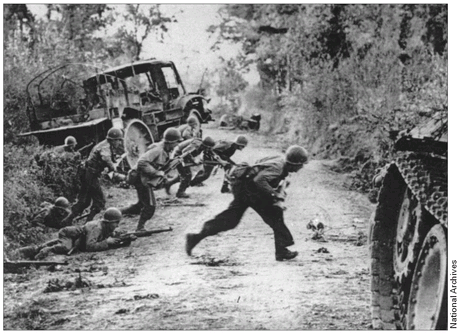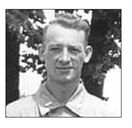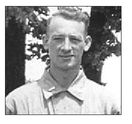War Stories III (34 page)
Authors: Oliver L. North

Some in Hitler's entourage claimed that the hiatus was proof that the Normandy landings could be contained and defeated. But others, including Colonel Claus von Stauffenberg, saw the Allied build-up at Normandy and the Red Army “
Bagration
” offensive on the Vistula east of Warsaw for what they wereâthe beginning of the end. He and a handful of senior officers decided it was time for a military coupâafter which they would sue for peace.
Bagration
” offensive on the Vistula east of Warsaw for what they wereâthe beginning of the end. He and a handful of senior officers decided it was time for a military coupâafter which they would sue for peace.
On 20 July, von Stauffenberg planted a small bomb beneath the conference room table at Hitler's Rastenburg headquarters in East Prussia. The blast wounded but failed to kill the Führerâwho launched an immediate
purge against any and all suspected of being part of the plot. Over the next nine months, some 5,000 Wehrmacht officers and civiliansâmost with no connection to the attempted coupâwere rounded up by the Gestapo and summarily shot. Othersâincluding the Desert Fox himself, Erwin Rommelâwere forced to commit suicide.
purge against any and all suspected of being part of the plot. Over the next nine months, some 5,000 Wehrmacht officers and civiliansâmost with no connection to the attempted coupâwere rounded up by the Gestapo and summarily shot. Othersâincluding the Desert Fox himself, Erwin Rommelâwere forced to commit suicide.
Â
U.S. troops advance at St. Lô.

Four days after the assassination attempt, with the British and Canadians still heavily engaged in the bloody fight for Caen, Bradley was ready to launch an American breakthrough from the Cotentin. Dubbed Operation Cobra, the attack was to commence immediately after 3,000 bombers and fighters from the 8th and 9th Air Forces “carpet bombed” German positions facing the four American infantry and two armored divisions west of St. Lô.
But Cobra had an inauspicious beginning. On the morning of 24 July the bombers dropped 4,000 tons of bombs through the heavy overcastâhitting the American lines with almost a third of the high explosives, killing thirty U.S. troops, wounding another 150, and causing Cobra to be
postponed for twenty-four hours. The following morning, with Bradley and Lieutenant General Leslie J. McNair looking on, the waves of B-17s returned. This time they swept over the American linesâinstead of parallel to themâand again they dropped 4,000 tons of bombs, hundreds of which hit the U.S. jumping off positionsâ
again.
postponed for twenty-four hours. The following morning, with Bradley and Lieutenant General Leslie J. McNair looking on, the waves of B-17s returned. This time they swept over the American linesâinstead of parallel to themâand again they dropped 4,000 tons of bombs, hundreds of which hit the U.S. jumping off positionsâ
again.
McNair and nearly all of his staff were killed outright. Another 400 GIs were killed and wounded. Bradley, watching from a café on a nearby hillside, barely escaped with his life. The 30th Infantry Division took the brunt of the casualties from the errant bombing, but still managed to get up out of their shallow fighting positions and launch the attack. Twenty-five-year-old Lt. Murray Pulver, a farm boy from upstate New York, a replacement in the 30th Division, was one of those who saw it happenâand still carried on. His resolve would be severely tested in the weeks ahead.
LIEUTENANT MURRAY PULVER, US ARMY
Company B, 120th Infantry,
30th Infantry Division
Near St. Lô, France
27 July 1944
30th Infantry Division
Near St. Lô, France
27 July 1944

We looked up and saw the B-17s coming from behindâinstead of across our front. And then the bombs started to fallâand we all took cover. It seemed like they took forever to hitâand the explosions went on and on all around us. I guess I repeated the Lord's Prayer and the 23rd Psalm a half a dozen times. General McNair was just off to the left side of my platoon when he was hit.
After the bombs stopped going off, everybody was in shockâwe were like a bunch of zombies. But even as the medics were treating the casualties, we were ordered to advance. I don't know how we did it, but everyone fell in and away we went.
I was new, having arrived on Omaha Beach on D + 6 as a replacement. A few days later I was assigned as a rifle platoon commander in B
Company, 120th Infantry Regiment, located near St. Lô. There was only one officer, besides the company commander, left in the company. After a few weeks of fighting through the hedgerows around St. Lô, there were probably only twenty-five to thirty men left in each of our three platoons.
Company, 120th Infantry Regiment, located near St. Lô. There was only one officer, besides the company commander, left in the company. After a few weeks of fighting through the hedgerows around St. Lô, there were probably only twenty-five to thirty men left in each of our three platoons.
The first time that I made contact with the Germans was when we made the first attack, along with A Company on our right. We had moved across two hedgerows, which was probably just 100 yards. And we were receiving heavy artillery and small arms fire. Then somebody hollered, “There's a tank coming down the road at us!”
I hollered for the bazooka man, and a young fellow by the name of Werner Yurtzâa German-American kidâcame running up to me with the bazooka. I said, “Fire at that tank.”
He looked at me and said, “I don't know how to fire it. I'm the ammunition carrier. The man that fires it was killed.”
I'd had a dry run with a bazooka in England, during trainingâbut I had never fired one before. But with Yurtz guiding my shot, I fired the bazooka, hit the tank, and it exploded. Within half an hour, I could hear someone from A Company calling for, “Bazooka, bazooka!” That time I got another tank behind a wall, about fifty yards in front of me. So now,
I'm
the bazooka man. In fact, I continued to be the bazooka man for the rest of the war.
I'm
the bazooka man. In fact, I continued to be the bazooka man for the rest of the war.
During Cobra we were supposed to move rapidly through the hole that the bombers made in the German lines and attack St. Giles, just west of St. Lô. Once there, the 3rd Armor Division would pass through our lines and head south.
On the way, we ran into more German tanks and paratroopers. The bombing had hurt them, but they fought hard. The German paratroopers were among the best soldiers in the war.
A few days later, at the town of Tessy-sur-Vire, I took over Company B. The captain went back to become a battalion commander. That's how bad the casualties were. At that point, I had 140 men in my company and I was the only officer.
On August 6 we reached the town of Mortain and B Company relieved elements of the 1st Division on Hill 285. When we took over their position, they said they hadn't seen any Germans in days. There was just twenty-nine feet difference in elevation between Hill 285 and Hill 314. The 1st Division pulled out and left the 30th Division strung out across the two hillsides. By nightfall on the sixth it looked like we had the Germans on the run. But all that was about to change.
What changed was Adolf Hitler's belief that a surprise Panzer counter-attack could somehow stop the American advance. With George Patton's newly formed 3rd Army dashing into Brittany and Courtney Hodges's 1st Army headed east, Hitler ordered Gunther von Kluge to send four Panzer Divisionsâthe 1st and 2nd SS, the 2nd, and the 116thâon a sweep south, then west to smash through the American lines and cut off Patton's rear at Avranches.
As the Führer conceived Operation Lüttich, the 300 tanks and 50,000 troops commanded by von Kluge would be reinforced in the battle by 1,000 more tanks from the 9th and 11th Panzer Divisions coming from the south of France and the 9th and 10th SS Panzer Divisions presently engaged at Caen. It would have been a brilliant strategy but for three factors: first, Allied bombing of the French rail and road networks made movement of armor on the scale envisioned impossible. Second, Ultra intercepts of German high command communications eliminated the element of surprise. And finally, for the German armor to get to Avranches, the Panzers would have to get through the 30th Infantry Division at Mortainâa quiet little village known for the Camembert cheese made on the dairy farms in the nearby rolling hillsides.
On 6 August 1944, as the German tanks started moving into position for the attack, Murray Pulver's Company B, 1st Battalion of the 120th Infantry Regiment occupied Hill 285, one of the two prominent terrain features in Mortain. Spread between 285 and the other commanding high ground, Hill 314, were Companies E, G, and H of 2nd Battalion, and K
Company of the 118th Infantry. Staff Sergeant Angel Garciaâthe son of an alfalfa farmer from Los Angeles, Californiaâled a machine gun squad in H Company and had his men deployed at the base of the hill. Second Lieutenant Robert Weiss, an artillery forward observer, was hoping for a quiet night when he climbed to the peak of 314 to establish an observation post late that afternoon.
Company of the 118th Infantry. Staff Sergeant Angel Garciaâthe son of an alfalfa farmer from Los Angeles, Californiaâled a machine gun squad in H Company and had his men deployed at the base of the hill. Second Lieutenant Robert Weiss, an artillery forward observer, was hoping for a quiet night when he climbed to the peak of 314 to establish an observation post late that afternoon.
Within hours, all three men would play key roles in the largest tank battle on the Western Front.
LIEUTENANT MURRAY PULVER, US ARMY
Company B, 120th Infantry,
30th Infantry Division
Hill 285, Mortain, France
7 August 1944
30th Infantry Division
Hill 285, Mortain, France
7 August 1944

At 0430, just before dawn, a Sherman tank, guided by two French civiliansâa man and a womanâapproached the roadblock I had set up below my CP near the top of Hill 285. They spoke a little English, and they told my sergeant at the roadblock that the American tank had gotten lost and they were guiding it back into friendly territory.
But it was a trick. It was a captured British Sherman. The crew was Germanâand so were the soldiers behind it. In the firefight that followed, I lost most of my first platoon. From then on, it was solid fighting for two days.
I moved my CP behind some farm buildings so that I could be centrally located between my two remaining platoons. Later that morning, the Germans attacked with more tanks and motorized infantry and blasted holes in every farm building.
At about dawn, I informed HQ that we were under heavy armor attack and that they were breaking through my roadblocks. We only had two anti-tank guns and the Germans managed to get a tank past them and
it came down the road to about thirty feet from us, just crawling along in the fog.
it came down the road to about thirty feet from us, just crawling along in the fog.
My first sergeant handed me a bazooka, and when I hit the tank, it stopped. But
where
it stopped, I could almost reach up and touch the muzzle of the 88 on that tank. That's how close they came to the stone wall we were hiding behind. Our radio was knocked out by heavy mortar fire, and the Germans either cut our telephone line, or it was knocked out by artillery fire so I lost communications with the second and third platoons. In fact we had no communications with anybody.
where
it stopped, I could almost reach up and touch the muzzle of the 88 on that tank. That's how close they came to the stone wall we were hiding behind. Our radio was knocked out by heavy mortar fire, and the Germans either cut our telephone line, or it was knocked out by artillery fire so I lost communications with the second and third platoons. In fact we had no communications with anybody.
After we knocked off the tank, several Germans, came across the field yelling, “Americans! Kamerad! Kamerad!” They were surrendering!
The good Lord was helping us that day. Though most of us were wounded that day, not one man in my company headquarters was killedâbut a whole lot of Germans were.
Fighting was sporadic during the night. The next day dawned clear and the Germans tried another tank-infantry attack across the open field. A British Typhoon fighter aircraft with a Canadian pilot saved us. He flew over and fired his rockets. They were so close that I could feel the heat from themâbut it broke off the attack.
The Typhoons and the artillery saved us but we were out of food and running low on ammunition. So in the midst of all the firing, my communicator and I took my jeep and drove back to battalion HQ. On the way we were hit by mortar fire. He was seriously wounded but I just got my teeth shattered. When I saw the battalion commander, he looked at me and said, “Where did you come from?” And I said, “From Mortain.”
“Well,” he said, “they told me that all of B Company had been captured or killed.”
I said, “No, we're still there. All I want is some food, water, and ammunition.” I also got a few men from battalion headquarters and we went back with the munitions and food and water.
I was called back to battalion headquarters on the third day, and we went to see the regimental commander. He could see that I was about done in, but he said, “I want you to take two platoons of your company and fight your way onto Hill 314, and deliver batteries and ammunition to them.” They had tried air-dropping supplies to the troops on 314 but it hadn't worked.
So my company pulled out in the dark the next morning and we went down into the valley, leapfrogging from one patch of woods to another. We ran into two German patrols, in strength, but we fought them off. At the crossroads we met our battalion's anti-tank company and a small contingent of infantry. The captain commanding the unit beamed all over when he saw us, and said, “Oh, thank God we got help.”
I said, “I'm sorry... I'm not here to help you. We've been ordered to deliver supplies up that hill.”
“You must be kidding!” he said, adding, “Come with me.” We went up a little rise, where we could get a full view of Hill 314 and the road going up. There were hundreds of dead Germans soldiers and destroyed tanks and other vehicles. A lot of them had been knocked out by our air force and artillery. But in between, there were a lot of live Germans as well. When I called back to battalion HQ on the radio they cancelled our resupply mission so in the dark we moved back to where we had started and resumed our old positions.
The fourth day was very quiet. But on day five of the battle we heard German officers giving orders from a tree line maybe fifty yards away as they got ready to attack us. I gave the signal for every man to fire at least two clips of ammunition, and toss hand grenades just when they started to advance in our direction. They must have thought we were a huge army, because the Germans pulled back and that finished 'em. Later that day we marched down the hill and into Mortain. The town was wrecked.
Other books
The Heartbroker by Kate O'Keeffe
Muddle and Win by John Dickinson
Kismet by Jakob Arjouni
April Love Story by Caroline B. Cooney
Breath of Desire by Ophelia Bell
Wake for Me (Life or Death Series) by Irons, Isobel
Lust (The Stripped Bare Series Book 1) by McKenzie, Elle
Kathy Hogan Trocheck - Truman Kicklighter 01 - Lickety-Split by Kathy Hogan Trocheck
The Wolf Moon (an erotic paranormal romance) (The Wolf Ring) by Harris, Meg
A Glint In Time (History and Time) by Frank J. Derfler
